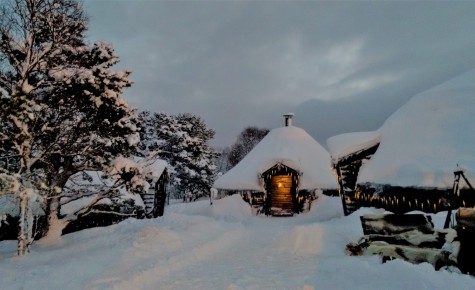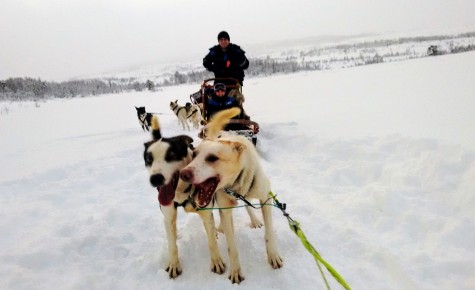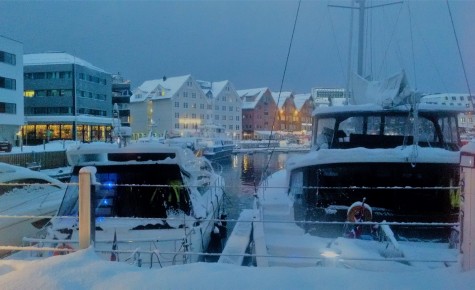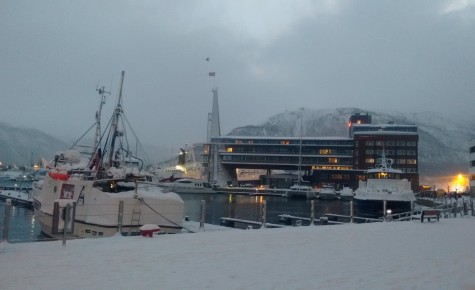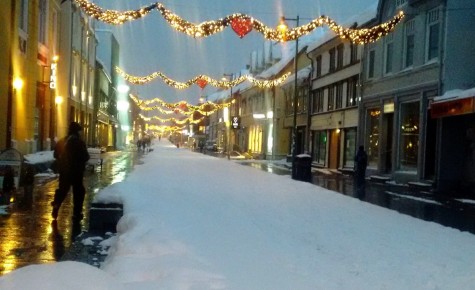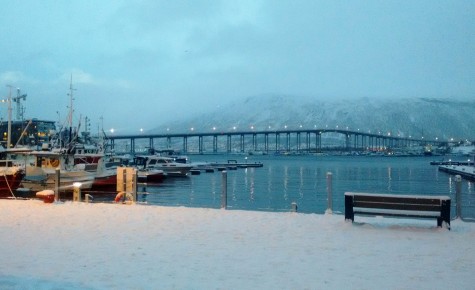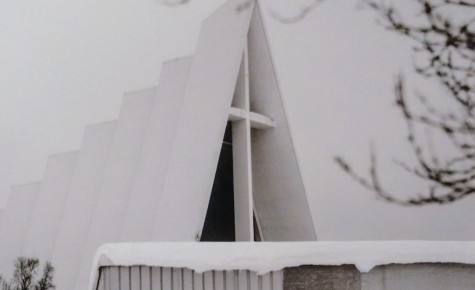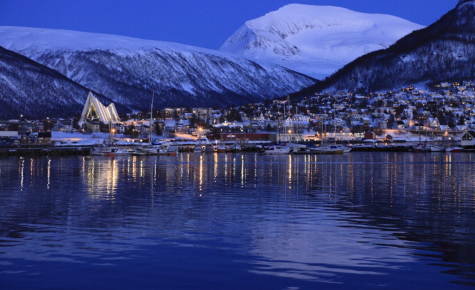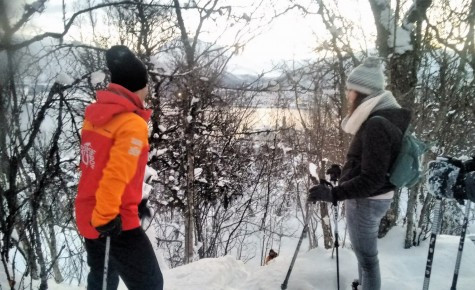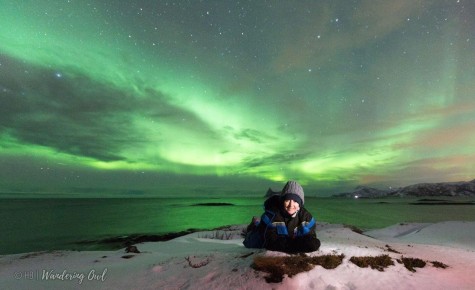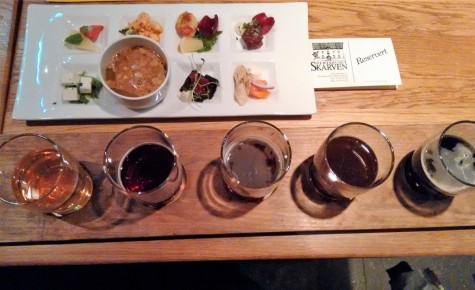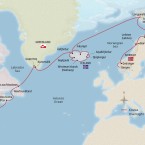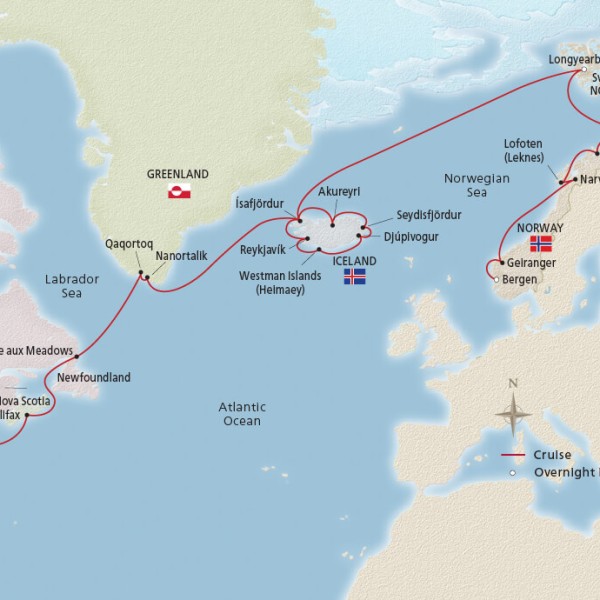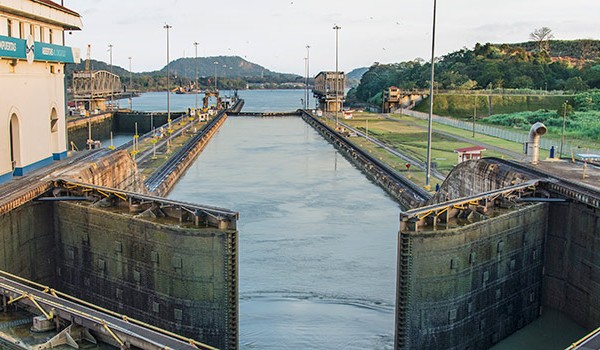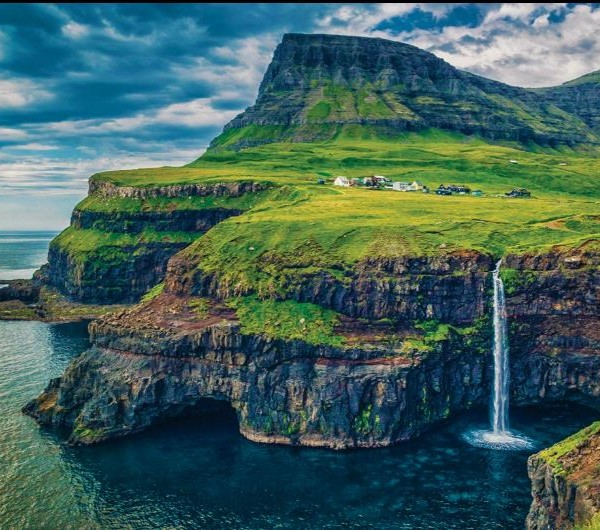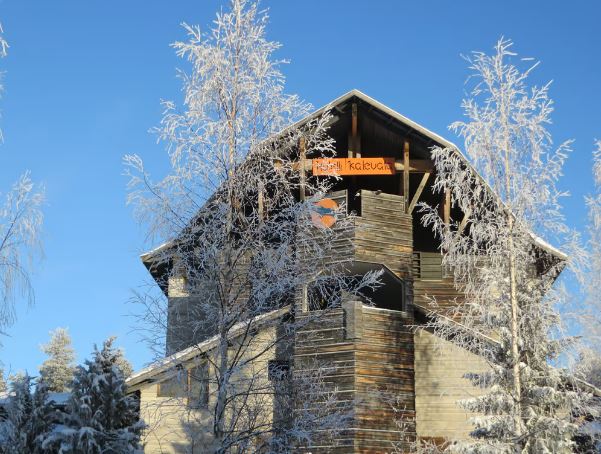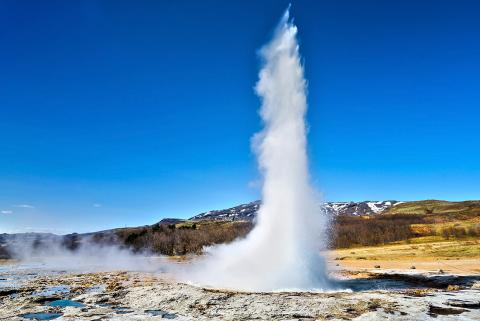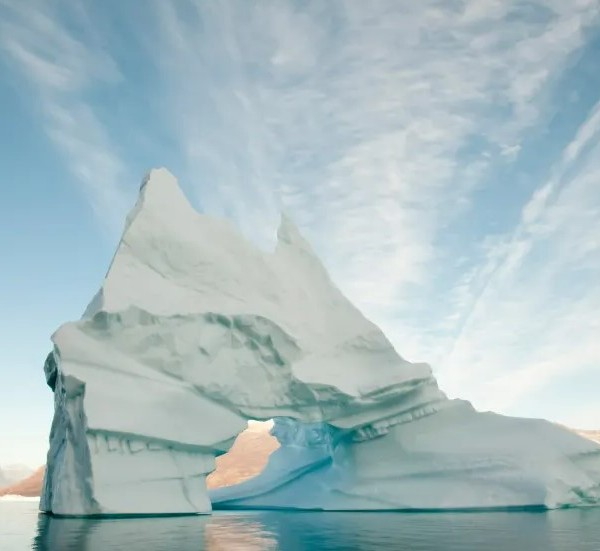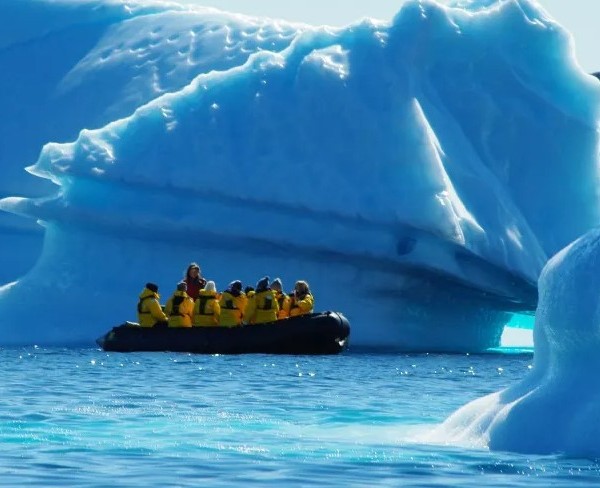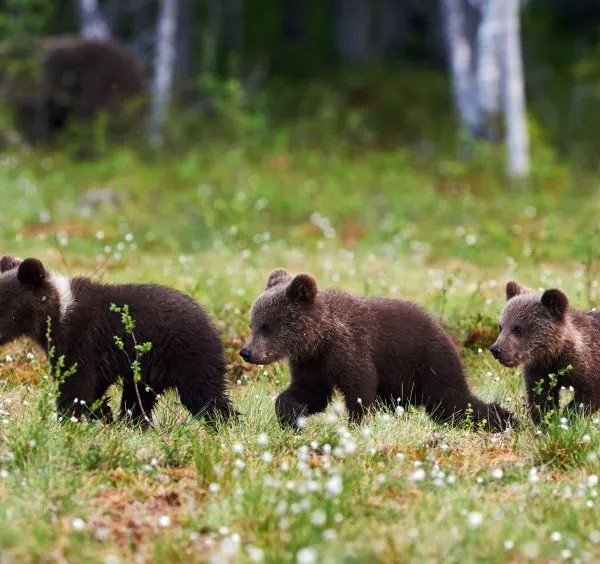Last summer I escaped soaring temperatures and heavy humidity in favour of snow-clad architecture, wintry landscapes and the charming markets of a European Christmas. Coupled with my long-held ambition to witness the Aurora Borealis, I flew to Tromsø, prime launch pad for a Northern Lights chase, all-round winter playground and hub of Arctic ‘cool’.
Situated 350km beyond the Arctic Circle and home to the world’s northernmost university, botanical gardens and distillery, Tromsø’s compact city centre is historical and characterful and has the highest number of wooden houses in northern Norway, the oldest dating from 1789. Its nightlife is vibrant and eclectic and, given its location, is the gateway to an array of Arctic adventures. Mine began when I touched down at 7.30pm to a mild -4°C, on 13th December.
The panoramic drive from the airport to my hotel was magical. Fallen snow had blanketed the landscape in thick, crunchy layers, raising the ground level to knee height. Houses became works of art; large illuminated stars glowed from their windows, colourfully twinkling trees lit up the rooms beyond and chimneys and aerials sculptured their snow-laden roofs beautifully. My hotel lobby was equally festooned with delightful Christmas ephemera. Toy trolls mischievously hiding in the distinctively aromatic giant spruce, along with the delicately hand-stitched ornamental Santa, gracing the armchair in the lounge as if it were its own. This was Christmas “Scandi” style – it felt like I’d stepped into my very own “Seasons Greetings” card – “god jul” as the locals say!
I’d heard of the ‘Polar night’ when the sun does not rise above the horizon for many months, but nothing prepared me for the dark sky that greeted the city at 9.30 the next morning. The day looked exactly like night. As this only occurs within the polar circles in winter, experiencing this seasonal occurrence was fascinating. After an indulgent breakfast of smoked Atlantic salmon, looking out over a frozen harbour, I set off on my first outdoor adventure – dog sledding.
At first glance, one might be forgiven for thinking that the sport of dog-sledding is unkind and immoral, yet huskies are working dogs and howl at the thought of running, as I was told by our knowledgeable guide. This appeared to be true as their inherent collective song wailed out in unison upon the previous sledding packs’ return. “They howl because they are jealous and want to be next”, said our guide. Braced for adventure, standing firmly on the runners of the sled, I released the brake and the pack launched forward. Strongly motivated by whatever it is that compels them, they accelerated at first, gathering pace, before trotting in perfect formation. The ride through the tundra was exhilarating; the day moving from relative darkness to a bluish twilight, the reflection of the snow a little blinding. At this time the sun skirts just below the horizon and as vividly etched in memory, tinged the sky with a changing palette of pastels, for a couple of hours.
24-hour darkness means 24-hour activity in Tromsø, for it is between the hours of 9 pm and 3 am when the Northern Lights are likely to be visible. They can appear at any time during the Polar night, often seen in the form of an arc or as swaying streams of green, pink, blue or yellow light, for an astonishing number of hours or a disappointing few minutes, if at all. Such is their fickle nature, that despite solar activity and weather conditions at their optimum, one’s chances of observation depend entirely on luck! Fortuitously, Tromsø offers its visitor an array of activities, unrelated to the Lights, in which to experience the Arctic.
That evening, I boarded a catamaran for a dinner cruise, hosted by skipper Gulli and his wife, Julia, in search of the Northern Lights. Julia prepared a deliciously light meal of freshly caught cod and winter vegetables, spoke of previous aurora sightings and how best to set one’s camera should a display appear. No more than an hour into the journey toward the open waters surrounding the fjords, we were told to head above deck – they were here!
At first, my eyes struggled to identify the streaky haze in the sky but with the aid of digital photography, I could inspect the Lights as my camera saw them. Swathes of green crossing a dark sky, almost crowning the water; Tromsø a mere row of dots on the distant horizon. Our hosts gave this sighting a 3 out of 10 for clarity but as this was my first, and maybe only sighting, I was thrilled to be able to capture the moment, in any possible form.
The next day local news broke of changes in the behaviour of marine life prevalent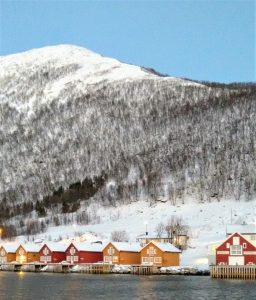 in the surrounding waters of nearby coves. Warmer waters meant absent herring; humpback whales and orcas, in pursuit of it wouldn’t be making an appearance either. Life is far less predictable for those for whom these waters are their livelihood. My wilderness safari diverted its itinerary to search for these migrating pods yet, despite the captain’s best efforts, we returned with only images of snow-covered peaks, rising boldly from the grey sea against a backdrop of shy, pink sky; a lone eagle soared alongside our vessel, chaperoning us back to shore. The inchoate light remains firm in my mind as beautifully stark in this Arctic wilderness.
in the surrounding waters of nearby coves. Warmer waters meant absent herring; humpback whales and orcas, in pursuit of it wouldn’t be making an appearance either. Life is far less predictable for those for whom these waters are their livelihood. My wilderness safari diverted its itinerary to search for these migrating pods yet, despite the captain’s best efforts, we returned with only images of snow-covered peaks, rising boldly from the grey sea against a backdrop of shy, pink sky; a lone eagle soared alongside our vessel, chaperoning us back to shore. The inchoate light remains firm in my mind as beautifully stark in this Arctic wilderness.
Sami people are the indigenous people of northern Scandinavia and have upheld most of their cultural traditions, not least reindeer herding. Historically, they lived by a ‘nose to tail’ diet where all parts of the animal were utilised for food, transport and clothing. While reindeer husbandry is more advanced today, it wouldn’t be possible without the maintenance of traditional knowledge, as I learned during my evening spent among the Sami of Tonsvik. And “bidos” – the food of the reindeer walkers, or herders, is a hearty stew you’re likely to be invited to experience at least once while in northern Norway. I especially enjoyed the warm reception in the Sami lavvo (tent) where we ate bidos and listened to cultural stories being told around a campfire, before returning to the sleek modernity of my hotel at midnight.
“Hit the hills for a bit of cardiovascular fun in the form of snowshoeing” read the flyer. Having never skied before I was somewhat dubious about how agile I might be, but after the guide introduced the mechanics of the shoe, resembling a snorkelling fin, we commenced our 2-hour ‘walkabout’. Meandering through undulating terrain interspersed with birch trees clad in fresh snow, stopping only to enjoy hot chocolate and regain our composure from laughing so much, it was, undoubtedly, one of the easiest activities to enjoy. And is now my new favourite winter workout – it’s a lot of fun.
With one remaining night in this gateway to the Arctic, I surrendered to fate once more in the hope that I might see the Lights again, in clearer skies. We ventured much further into the frostbitten wild, some 3 hours away from Tromsø, where the mercury had dipped to -12°C, arriving at a beach, curving around a steep bay. Wearing triple layers of warmth, we sauntered over the sand dunes and set up camp in preparation for our ‘chase’. “Green-fever” had taken hold as the guide’s interpretation of the night sky and conditions inferred possible success this evening. Sightings can neither be predicted nor guaranteed but clear skies and minimal light pollution favour the opportunity.
After an hour of waiting, my enthusiasm started to wane somewhat, it was frightfully cold. Suddenly, while lying beneath an illuminated night sky, hoping not to lose sensation in my feet, time stopped the moment the Lights came into view. From nowhere emerged a green haze which gradually became clearer, before the Lights started to dance above me in all their glory, leaving some of the group a little emotional, describing this hunt as something of a pilgrimage for them. Few words were spoken on the bus back to the hotel, quiet contentment and exhaustion had left us all a little sleepy. It was almost 2.30am.
Sundays are religiously observed in Tromsø; retail trading is minimal at best but museums and churches are open. Despite the snow flurries, the main streets of Tromsø’s town centre are heated, enabling paths to be cleared of potentially hazardous and slippery melting snow. Armed with my trusty snow boot accessories, “gripper spikes”, I could take in the attractions of this compact town on foot, easily and without calamity.
A worthy mention is the Polar Museum. Exhibits include extensive historical artefacts from both the southern and northern polar expeditions dating back to the 1600s. Later, a 20-minute walk over the Tromsø Bridge took me to the Arctic Cathedral, an impressive structural landmark visible from the centre of Tromsø, where the local choir practised carols for their Christmas performance – an unexpected pleasure to hear. Walking back to the city, I called in at the Perspektivet Museum. Housed in a quaint, historical building, it has various photographic exhibitions, including a retrospective look at Sami culture and a marvellous collection of black and white images dating back to the sixties. Ending my visit to Tromsø, I joined a beer safari for a taste of Tromsø’s developing craft beer movement. Hosted by locals who delight in sharing their craft and witty historical commentary, we drank beer and nibbled our way through an assortment of Arctic delicacies – a great way to fill in the afternoon.
 Being a seafaring nation, Norway’s coastline is dotted with villages and towns which are serviced by an extensive network of ships and ferries. Leaving Tromsø by ship, I chose to venture to the northernmost point of Norway, and continental Europe, where the “Children of the World” sculpture, located at Nordkapp, or 71 Degrees North, stands. Gazing out at the North Atlantic, I marvelled at the Vikings’ efforts to navigate this wild frontier. There is also an interpretive centre and an underground chapel, possibly the smallest, but certainly, the world’s northernmost ecumenical, seating 16. The journey at sea was very comfortable with ample facilities to while away the hours between port. As I arrived in Kirkenes, soon to depart Norway, despite the absence of the sun, the morning sky was now pastel pink, and in my mind – a perfect ‘dawn’ and grand send-off to my week-long magical adventure.
Being a seafaring nation, Norway’s coastline is dotted with villages and towns which are serviced by an extensive network of ships and ferries. Leaving Tromsø by ship, I chose to venture to the northernmost point of Norway, and continental Europe, where the “Children of the World” sculpture, located at Nordkapp, or 71 Degrees North, stands. Gazing out at the North Atlantic, I marvelled at the Vikings’ efforts to navigate this wild frontier. There is also an interpretive centre and an underground chapel, possibly the smallest, but certainly, the world’s northernmost ecumenical, seating 16. The journey at sea was very comfortable with ample facilities to while away the hours between port. As I arrived in Kirkenes, soon to depart Norway, despite the absence of the sun, the morning sky was now pastel pink, and in my mind – a perfect ‘dawn’ and grand send-off to my week-long magical adventure.
The mesmerising and mystical dance of the Aurora, the Polar night and adventurous lifestyle of this urban Arctic gem made Tromsø the perfect antidote to summer’s wilt – just imagine what you could experience in 24 hours of daylight when the midnight sun turns on the charm!





